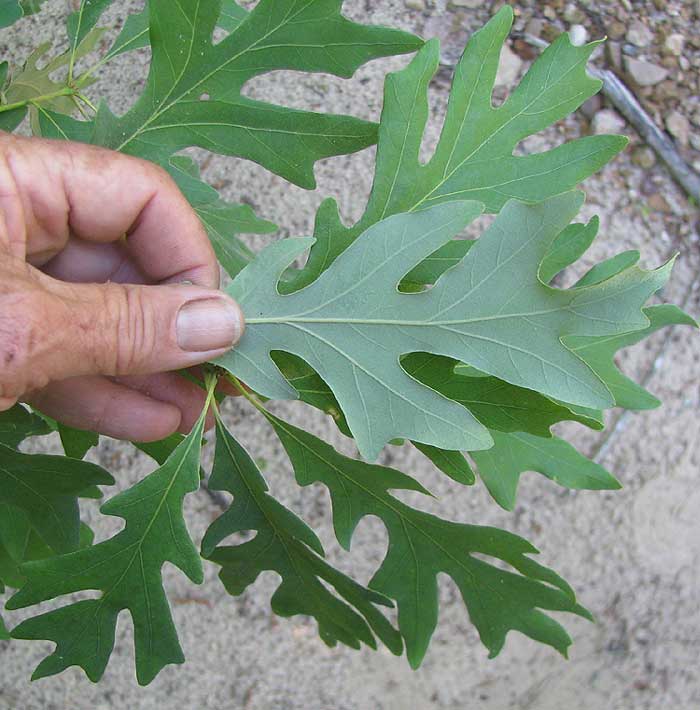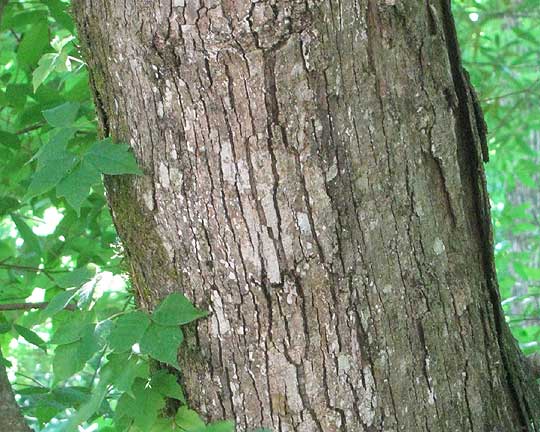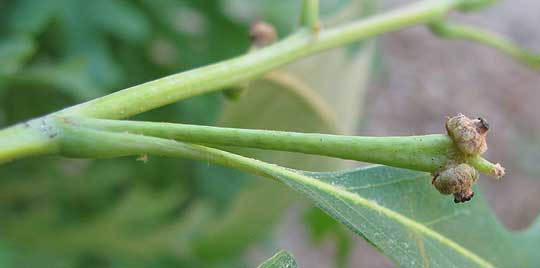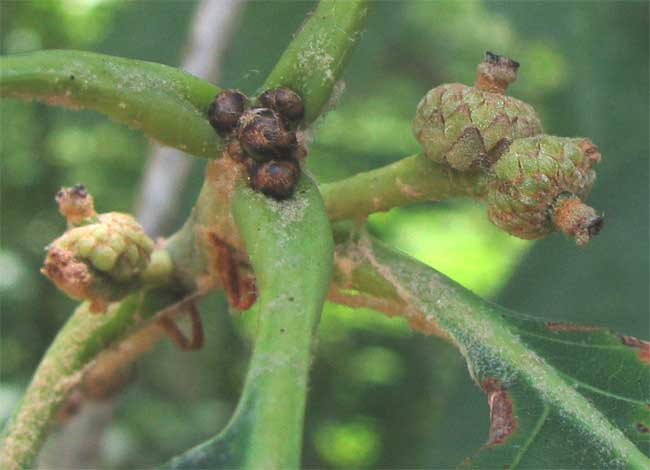Excerpts from Jim Conrad's
Naturalist Newsletter

from the April 29, 2012 Newsletter issued from the woods of the Loess Hill Region a few miles east of Natchez, Mississippi, USA
ADMIRING THE WHITE OAK
For me nothing is prettier than a tree, and one of the most graceful and good-to-look-at trees is the White Oak of eastern North America, QUERCUS ALBA. If I had to pick a
"representative tree leaf," I'd pick White Oak leaves such as those shown above. In that picture I'm holding a leaf so you can see its underside, much paler than other leaves' topsides. The tree's gray bark of narrow, vertical blocks of scaly plates is shown below:

I'm accustomed to seeing White Oaks on relatively dry upland soils so I was a little surprised when the tree in the picture showed up on a stream bank growing among Sycamores. In fact, White Oaks are fairly rare around here, completely absent in many upland forests where I'd expect them to be. Years ago I mentioned this in a Newsletter and a local reader responded that in this region White Oaks were wiped out many years ago by people cutting them as lumber and, more importantly, using them in the whisky distilling business. The online Flora of North America says that "In the past Quercus alba was considered to be the source of the finest and most durable oak lumber in America for furniture and shipbuilding."
There beside the stream, last year's crop of our White Oak's acorns had been washed away, but this season's were there in their first stages of growth, as seen below:

Traditionally early North Americans regarded the inner bark of White Oaks as highly medicinal. Extracts made from soaking the inner bark in water are astringent (puckery) and were used for gargling, and the old herbals describe the extract as tonic, stimulating and antiseptic. Other listed uses include for "putrid sore throat," diphtheria, hemorrhages, spongy or bleeding gums, and hemorrhoids. Many applications suggest adding a bit of capsicum, or hot pepper, to the extract.
Basically the notion seems to be that the bark's tannin -- the puckery element -- does the main medicinal service. Other oaks actually have more tannin than White Oak, but medicines made with them can be too harsh. White Oak extracts seem to have just the right amount.
The same tannin situation exists with regard to the edibility of acorns. The acorns of other oaks contain more tannin so they require more time and effort to make them edible. White Oak acorns have much less tannin, but even still there's enough to make them too bitter for humans to eat without treatment, which traditionally has been leaching acorn pulp in running water.
By the way, instructions for the kitchen leaching of acorn pulp appear at http://www.ehow.com/how_8427141_leach-acorns.html.
from the June 9, 2008 Newsletter, issued from the forest near Natchez, Mississippi; elevation ~400ft (120m), ~N31.47°, ~W91.29°:
BABY WHITE-OAK ACORNS
At Pipes Lake {~N31.38°, ~W91.16°, elev. ~140ft (~40m)} the White Oaks, QUERCUS ALBA, flowered weeks ago and the dangling, yellow, wormlike catkins of male flowers have long fallen off. However, very immature White Oak acorns already can be seen if you look for them. They're smaller than BBs and each acorn consists only of a tiny scaled cup from which the old stigma and style project, with the nut itself not yet visible. You can see some baby White Oak acorns below:
